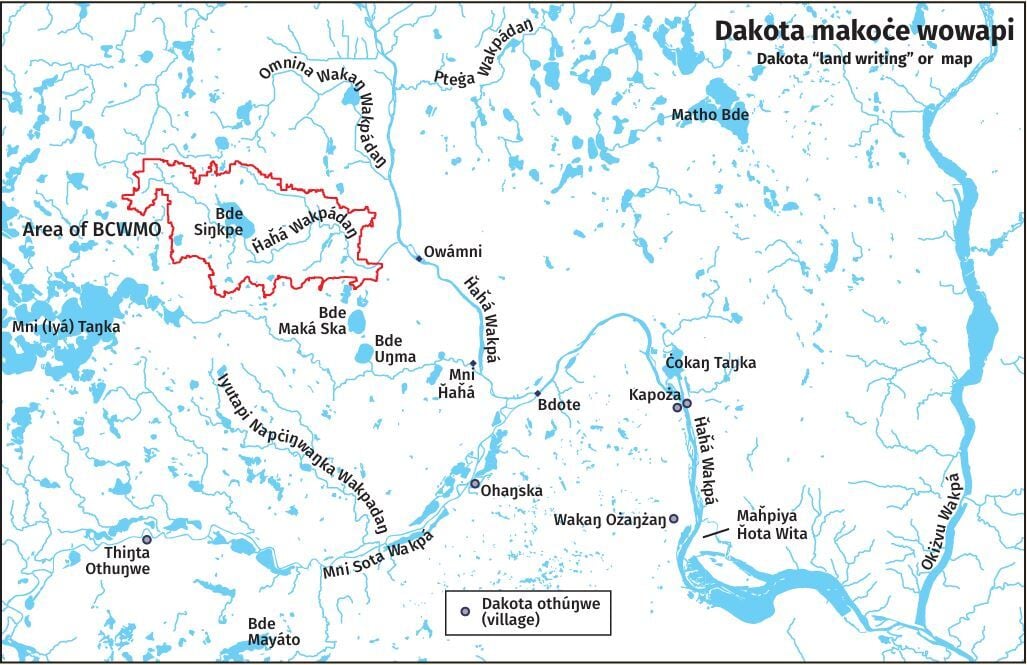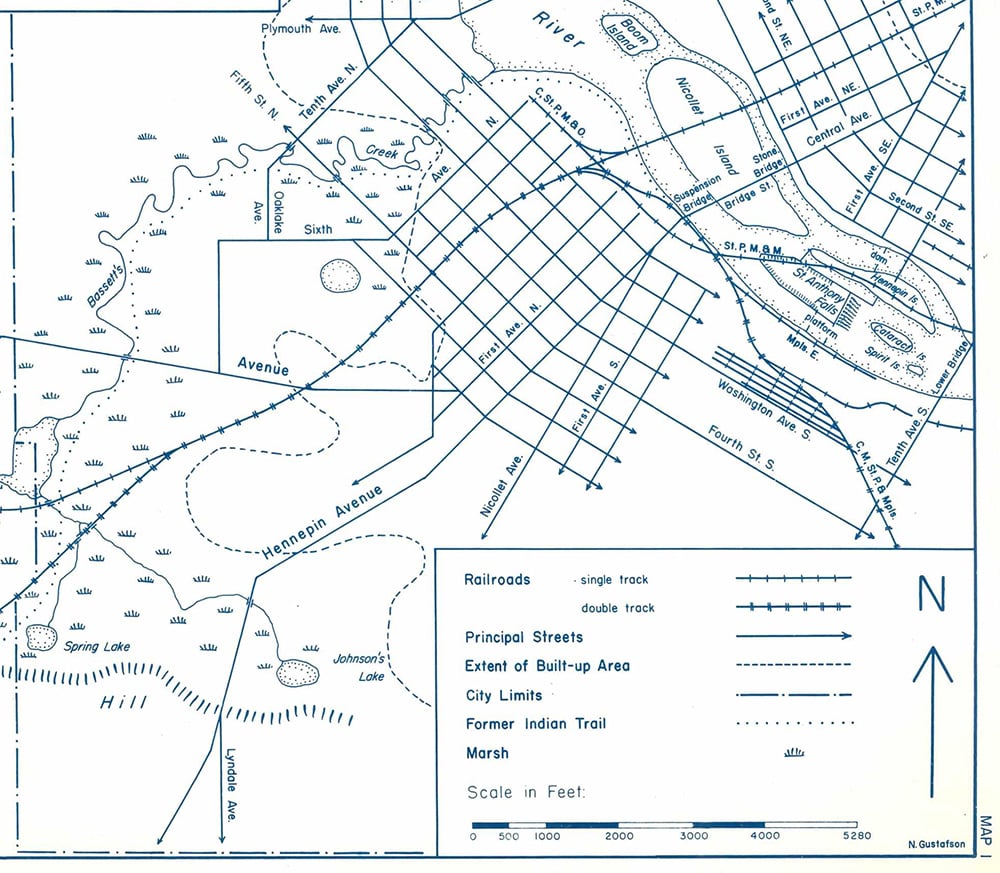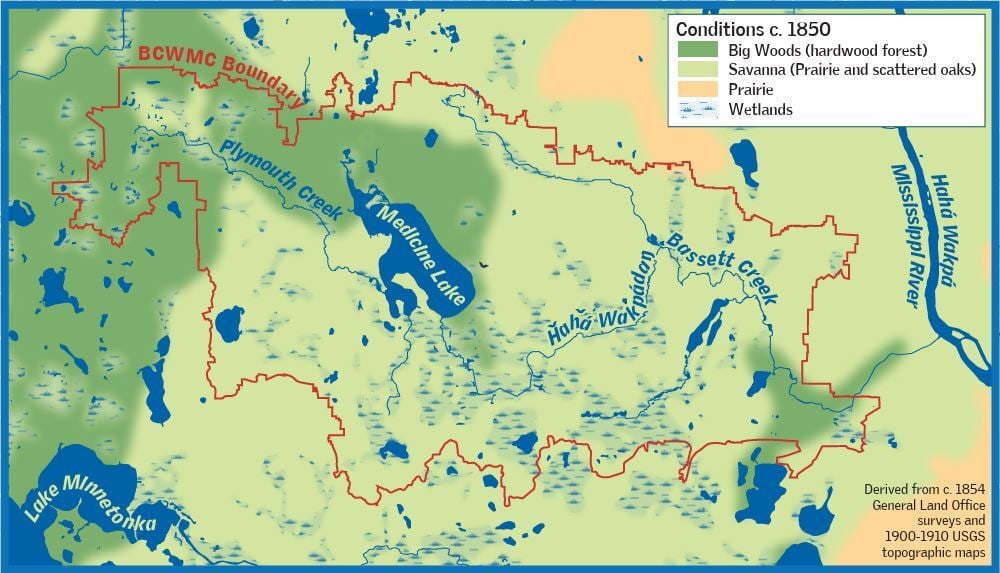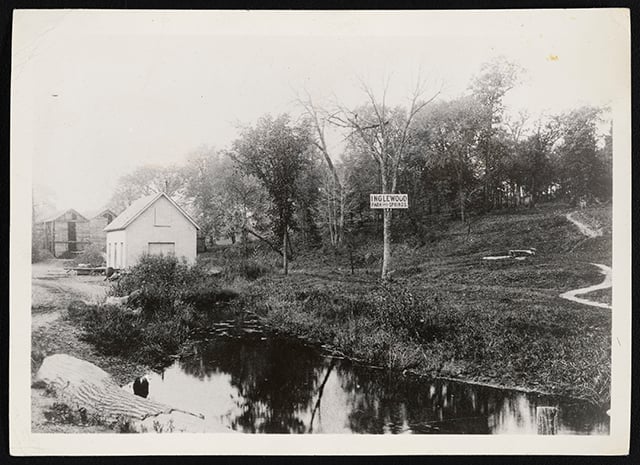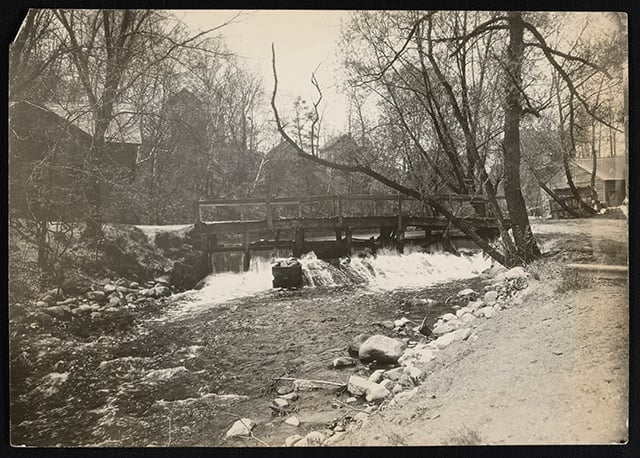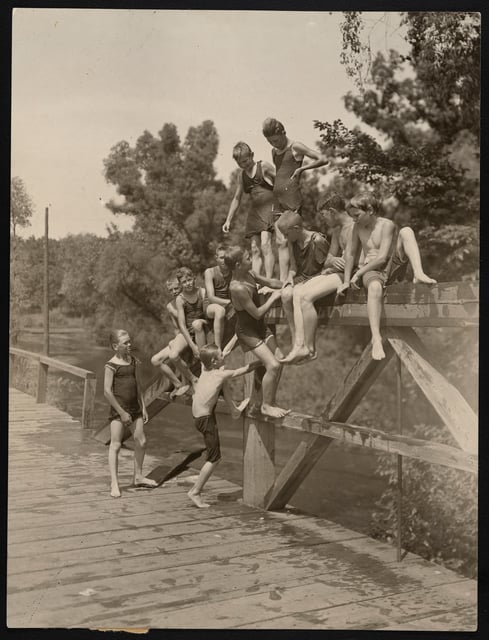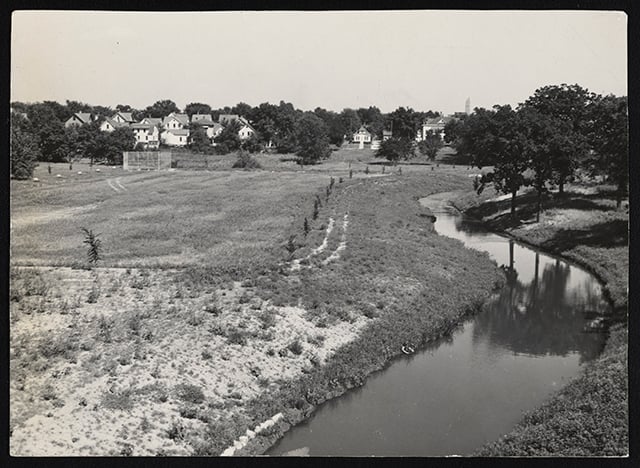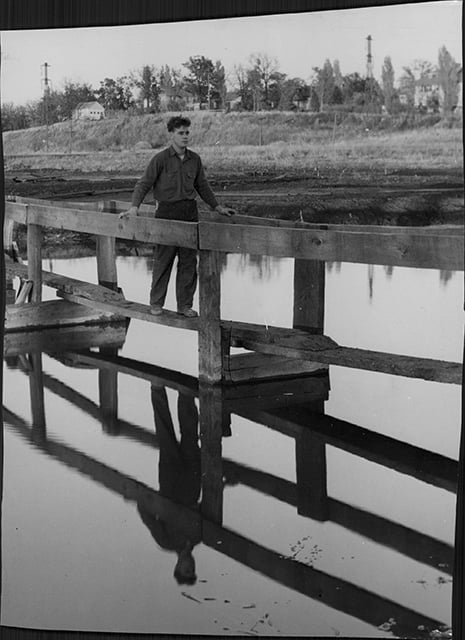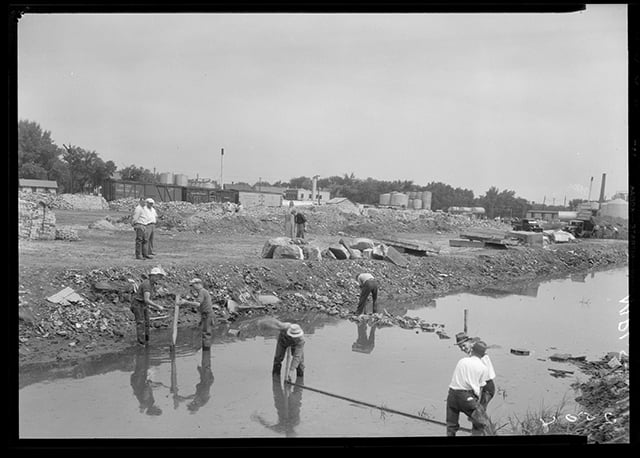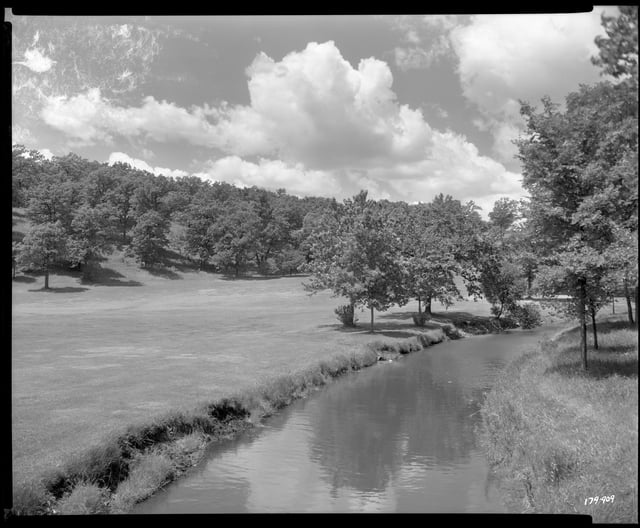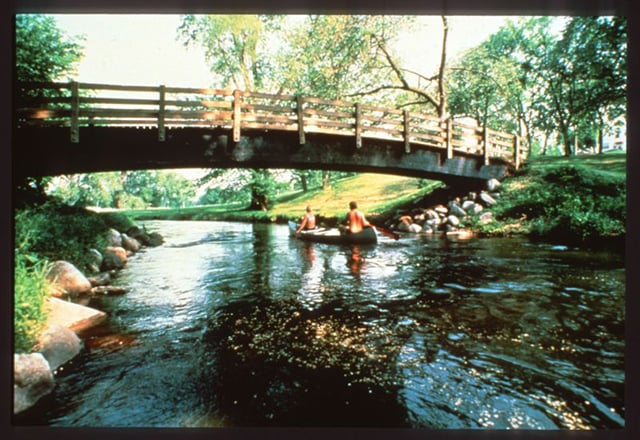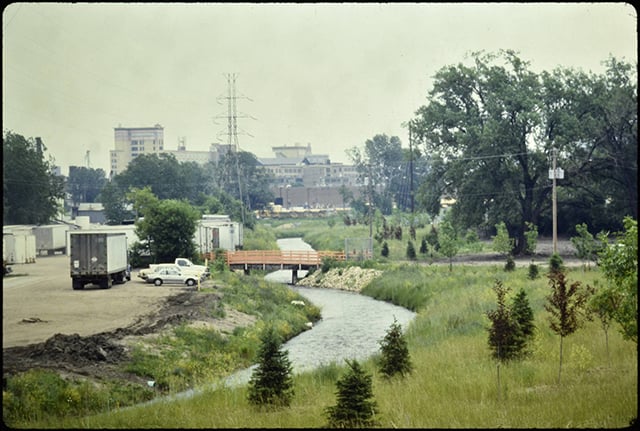Ȟaȟá Wakpádaŋ (Bassett Creek)
Bibliography
AJRAMiller. “Bassett Creek: Moving from the Drained City to the Waterways City, and Beyond?” Fishing the City, March 31, 2016.
https://urbanfishingproject.wordpress.com/tag/bassett-creek
Anfinson, John. River of History: A Historic Resources Study of the Mississippi National River and Recreation Area. National Park Service, 2003.
https://www.nps.gov/miss/learn/historyculture/historic_resources.htm
Anfinson, Scott F. “Archaeology of the Central Minneapolis Riverfront.” Minnesota Archaeologist 48, nos. 1–2 (1989).
https://www.fromsitetostory.org/sources/papers/mnarch48/48inv-bc.asp
——— . “Urban Archaeology: The Minneapolis Riverfront.” Hennepin History 52, no. 3 (Summer 1993).
https://digitalcollections.hclib.org/digital/collection/p17208coll13/id/4238
Bassett Creek Flood Control Commission. Watershed Management Plan for Bassett Creek; prepared for the Bassett Creek Flood Control Commission and Member Communities. Barr Engineering Company, 1972. Available at the Minnesota Historical Society library as TC424.M6 B372 1972.
https://mnpals-mhs.primo.exlibrisgroup.com/permalink/01MNPALS_MHS/ge68j0/alma990015947740104294
Bassett Creek Flood Control Commission records, 1976–1979
State Archives, Minnesota Historical Society, St. Paul
Description: Records of the Bassett Creek Flood Control Commission, formed in 1969 under a Joint Powers Agreement of the Hennepin County municipalities of Crystal, Golden Valley, Medicine Lake, Minneapolis, Minnetonka, New Hope, Plymouth, Robbinsdale, and St. Louis Park, to provide for cooperation in the investigation, planning, and implementation of flood control measures in the Bassett Creek watershed.
https://storage.googleapis.com/mnhs-finding-aids-public/library/findaids/bcfccomm.pdf
Bassett Creek Watershed Management Commission. “BCWMC Flood Control Project and Tunnel.”
https://www.bassettcreekwmo.org/application/files/6914/4424/7362/FloodControlProjectandTunnel.pdf
——— . “About Main Stem Bassett Creek.”
https://www.bassettcreekwmo.org/lakes-streams/main-stem-bassett-creek
——— . “BCWMC’s History.”
https://www.bassettcreekwmo.org/about/our-history
——— . “Creek Co-naming Practices.”
https://mail.bassettcreekwmo.org/application/files/5117/3706/7903/Equity_Related_Policies_and_Practices.pdf
——— . “Fiftieth Anniversary, 1969–2019” [brochure].
https://www.bassettcreekwmo.org/application/files/2215/6201/7207/BCWMC_50th_Brochure_for_web.pdf
——— . “Ȟaȟá Wakpádaŋ & Indigenous Culture.”
https://www.bassettcreekwmo.org/haha-wakpadan-indigenous-culture
——— . “Ȟaȟá Wakpádaŋ / Bassett Creek Watershed.”
https://www.bassettcreekwmo.org/application/files/3217/5260/4766/Watershed_map_1-21-25_not_password_protected.pdf
Bassett Creek Flood Control Commission. Watershed Management Plan for Bassett Creek; prepared for the Bassett Creek Flood Control Commission and Member Communities. Barr Engineering Company, 1972. Available at the Minnesota Historical Society library as TC424.M6 B372 1972.
https://mnpals-mhs.primo.exlibrisgroup.com/permalink/01MNPALS_MHS/ge68j0/alma990015947740104294
Bassett Creek Flood Control Commission records, 1976–1979
State Archives, Minnesota Historical Society, St. Paul
Description: Records of the Bassett Creek Flood Control Commission, formed in 1969 under a Joint Powers Agreement of the Hennepin County municipalities of Crystal, Golden Valley, Medicine Lake, Minneapolis, Minnetonka, New Hope, Plymouth, Robbinsdale, and St. Louis Park, to provide for cooperation in the investigation, planning, and implementation of flood control measures in the Bassett Creek watershed.
https://storage.googleapis.com/mnhs-finding-aids-public/library/findaids/bcfccomm.pdf
Bassett Creek Watershed Management Commission. “BCWMC Flood Control Project and Tunnel.”
https://www.bassettcreekwmo.org/application/files/6914/4424/7362/FloodControlProjectandTunnel.pdf
——— . “About Main Stem Bassett Creek.”
https://www.bassettcreekwmo.org/lakes-streams/main-stem-bassett-creek
——— . “BCWMC’s History.”
https://www.bassettcreekwmo.org/about/our-history
——— . “Creek Co-naming Practices.”
https://mail.bassettcreekwmo.org/application/files/5117/3706/7903/Equity_Related_Policies_and_Practices.pdf
——— . “Fiftieth Anniversary, 1969–2019” [brochure].
https://www.bassettcreekwmo.org/application/files/2215/6201/7207/BCWMC_50th_Brochure_for_web.pdf
——— . “Ȟaȟá Wakpádaŋ & Indigenous Culture.”
https://www.bassettcreekwmo.org/haha-wakpadan-indigenous-culture
——— . “Ȟaȟá Wakpádaŋ / Bassett Creek Watershed.”
https://www.bassettcreekwmo.org/application/files/3217/5260/4766/Watershed_map_1-21-25_not_password_protected.pdf
——— . Map of the Ȟaȟá Wakpádaŋ / Bassett Creek Watershed.”
https://www.bassettcreekwmo.org/application/files/4017/3739/3834/2025_watershed_map_FINAL_for_WEB.pdf
——— . “Secrets of the Bassett Creek Watershed.”
https://www.bassettcreekwmo.org/application/files/1816/1823/7519/BCWMC_Back_of_Map.pdf
Joel B. Bassett papers. 1859–1876 (bulk 1865–1868)
Manuscripts Collection, Minnesota Historical Society, St. Paul
Description: Correspondence, reports, treaty drafts, payment vouchers, applications for Indian trader licenses, and similar documents relating mostly to Bassett's work while agent at the Chippewa Agency, Crow Wing, Minnesota (1865–1869).
https://storage.googleapis.com/mnhs-finding-aids-public/library/findaids/p2243.html
Bergstrom, Matt. “Adventure in Bassett’s Creek.” Explorer Rag 1, no. 7 (August 1989).
https://www.mnmuseumofthems.org/Archives/XRag/XRagBassetts.html
Beyer, Bill. “A Mile of Riverfront, A Buried Creek, and a Freeway Undone.” Hennepin History 80, no. 1 (2021): 20–24.
https://digitalcollections.hclib.org/digital/collection/p17208coll13/id/17733/rec/1
——— . Personal communication with the author, 2025.
Biber, Josh. “The History of a Hidden, Toxic Creek That Still Flows Below North Loop.” Racket, August 3, 2022.
https://racketmn.com/bassett-creek-minneapolis-north-loop-history
Biber, Josh. “The Sick Creek in the City of Lakes.” The Minnesota Historian (blog). August 2, 2022.
https://www.minnesotahistory.org/post/the-sick-creek-in-the-city-of-lakes
The Biographical Dictionary and Portrait Gallery of Representative Men of Chicago, Minnesota Cities and the World’ Columbian Exposition. American Biographical Publishing Company, 1892.
https://archive.org/details/biographicaldict02amer/page/882/mode/1up?q=bassett
Blomfield, Edward A., ed. “The Laycock’s [sic], Pioneers of St. Louis Park.” Hennepin County History: A Quarterly Bulletin 5, no. 19 (July 1945): 5.
https://digitalcollections.hclib.org/digital/collection/p17208coll13/id/566/rec/2
Borchert, Jane, et al. “Golden Valley Trails of Yesteryear.” Trail map (A0288), 1960. MN Collections.
https://mncollections.org/Detail/objects/409008
Brandt, S. “Downtown Minneapolis Park Ideas Bubbling in Planning for Next 25 Years.” Minneapolis Star Tribune. December 9, 2015.
https://www.startribune.com/downtown-minneapolis-park-ideas-bubbling-in-planning-for-next-25-years/361249421
Bray, Martha C., ed. The Journals of Joseph Nicollet: A Scientist on the Mississippi Headwaters, With Notes on Indian life, 1836–37. Minnesota Historical Society, 1970.
https://archive.org/details/journalsofjoseph0000nico/page/226/mode/2up
CCX Media. “Golden Valley’s Environmental Initiatives Focus on Water Quality,” March 2025.
https://ccxmedia.org/cities/golden-valleys-environmental-initiatives-focus-on-water-quality
City of Crystal. “Appendix H: Local Surfacewater Management Plan.” Section 3.3, p. 16, 2018.
https://cdnsm5-hosted.civiclive.com/UserFiles/Servers/Server_10879634/File/Resident/Community%20Development/LocalSurfaceWaterPlan.pdf
City of Minneapolis. “Appendix F: Wastewater.” Section 4–1, l. 174, 2018.
https://minneapolis2040.com/media/1445/minneapolis2040-appendix-f_12_19_18.pdf
M/A 0105
Minneapolis Aquatennial Collection
Hennepin County Library Special Collections, Minneapolis
Description: The collection contains programs, scrapbooks, photographs, newspaper clippings, financial records, meeting minutes, press releases, realia (including buttons and plaques), and assorted papers documenting the Minneapolis Aquatennial from 1940 to the present.
https://archives.hclib.org/repositories/sc/resources/collection_on_the_minneapolis_aquatennial
Cornejo, Dan. “Daylighting Creeks in Hennepin County: Recommended Locations for Feasibility Study.” Cornejo Consulting, 2006.
http://finog.org/bridal_veil/docs/daylighting.pdf
Davenport, John. “The Forgotten History of Bassett Creek.” Hennepin History Museum, April 29, 2022.
https://hennepinhistory.org/the-forgotten-history-of-bassett-creek
DeCarlo, Peter. “Lines on the Land: How Dakota Homeland Became Private Property; A History of the South Loop District to 1900.” Prepared for the City of Bloomington Creative Placemaking in the South Loop Board of Commissioners, August 29, 2021.
https://www.bloomingtonmn.gov/sites/default/files/2023-03/South%20Loop%20History%20Report_Creative%20Placemaking.pdf
Du, Susan. “Why Did Minneapolis Bury Bassett Creek?” Minneapolis Star Tribune, June 13, 2024.
https://www2.startribune.com/why-was-bassett-creek-hidden-underground-and-where-does-it-flow-now/600372674
Durand, Paul. Where the Waters Gather and the Rivers Meet: An Atlas of the Eastern Sioux. Paul Durand, 1994.
Ek, Trinity. “Hidden Waterways: Bassett Creek.” Open Rivers: Rethinking Water, Place, and Community 18 (2021).
https://openrivers.lib.umn.edu/article/hidden-waterways-bassett-creek
Folwell, William Watts. “The Sale of Fort Snelling, 1857.” Minnesota Historical Collections, vol. XV (1915): 397.
https://archive.org/details/saleoffortsnelli00folwrich/page/396/mode/2up
Foster, Lysander P. “Dr. Lysander P. Foster–1849.” In Old Rail Fence Corners: The A.B.C.’s of Minnesota History. Edited by Lucy L. W. Morris. F. H. McCulloch Printing Corporation, 1914.
https://archive.org/details/oldrailfencecorn00morr/page/38/mode/2up?q=bassett%27s+creek
Friends of Bassett Creek. “A Brief Description and History of Bassett Creek.” May 10, 2003. Saved by the Internet Archive Wayback Machine, October 6, 2024.
https://web.archive.org/web/20241006194034/http://www.mninter.net/~stack/bassett/descript.htm
Goetz, Edward G. Hollman v. Cisneros: Deconcentrating Poverty in Minneapolis. Reports 1–8. University of Minnesota Center for Urban and Regional Affairs, 2002.
https://www.housinglink.org/files/hollman-compilation.pdf
Golden Valley Historical Society. Golden Valley: A History of a Minnesota City, 1886–1986. Golden Valley Historical Society, 1986.
Gustafson, Neil C. “Bassett’s Creek: A Case Study on the Changing Concepts in Urban Land Use.” Diss., 1959. Available at the Minnesota Historical Society library as F613 .M68B3 .G8.
https://mnpals-mhs.primo.exlibrisgroup.com/permalink/01MNPALS_MHS/ge68j0/alma990016456960104294
“Ȟaȟa Wakpádaŋ / Bassett Creek Oral History Project.” Interviews by Dr. Kasey Keeler, 2022. MN Collections.
https://mncollections.org/Gallery/3964
Hamilton, William J. “Old North Minneapolis: Below Plymouth and Lyndale Avenues.” Hennepin County History 17, no. 4 (Winter 1958): 17–18. https://digitalcollections.hclib.org/digital/collection/p17208coll13/id/4906
“Hennepin County’s Brownfield Interim Use Study: Bassett Creek Valley.” Bryn Mawr Bugle, June 1, 1999.
https://digitalcollections.hclib.org/digital/collection/p17208coll7/id/34415
“WPA Workers at Bassett’s Creek.” Black and white photograph, 1935. Minneapolis Newspaper Photograph Collection, Hennepin County Library Digital Collections (P12174).
https://digitalcollections.hclib.org/digital/collection/MplsPhotos/id/12885/rec/61
Hennepin History Museum. “Ȟaȟá Wakpádaŋ / Bassett Creek Oral History Project.” Interview recordings on YouTube.
https://www.youtube.com/playlist?list=PL5bNwUXzx9nffXi-Sj3AF3DCyhrb0TrT5
Hoisington Koegler Group, Inc. “Bassett Creek Valley Master Plan.” Redevelopment Oversight Committee, 2007.
https://minneapolis2040.com/media/1502/bassett-creek-valley-master-plan.pdf
“How to Pronounce Ȟaȟá Wakpádaŋ.” Educational Video. Contributions by Šišóka Duta, Jim Rock, and students from Bdote Learning Center. Produced by Valley Community Presbyterian Church, September 28, 2023. YouTube, 2 min., 42 sec.
https://www.youtube.com/watch?v=IwDrekIIiNM.
“In a Normal Condition.” St. Paul Daily Globe, July 30, 1892.
https://newspapers.mnhs.org/jsp/PsImageViewer.jsp?doc_id=ccbd77b2-b2c5-425f-8a1f-675f2576f46e%2Fmnhi0031%2F1HMADE59%2F92073001
Jarrett, J. J. “Subdivision of Township No. 29 North, of Range 24 West of 4th Principal Meridian, Minnesota.” U.S. Department of the Interior Bureau of Land Management, vol. 14166 (1853): M250.
https://glorecords.blm.gov/details/fieldnote/default.aspx?dm_id=232136&s_dm_id=94151&sid=wem2tzis.uxs
Kadinsky, Sergey. “Bassett Creek, Minneapolis.” Hidden Waters Blog, June 27, 2016.
https://hiddenwatersblog.wordpress.com/2016/06/27/bassett-creek-minneapolis
Keeler, Kasey. “Beyond the White Picket Fence: American Indians, Suburbanization, and Homeownership.” American Indian Culture and Research Journal 47, no. 2 (2024): 97–115.
https://escholarship.org/uc/item/4417z1s0
“Land Speculation in Minnesota.” Weekly Shelby News, January 14, 1857.
https://archive.org/details/xt776h4cr24b/page/n1/mode/2up?q=%22bassett%27s+creek%22
Lowell, Anne Kessen. McCormack Baron, 1973–2023: A Legacy of Community Partnership, Housing Innovation, and Reinvestment in America’s Urban Neighborhoods. McCormack Baron, 2023.
https://www.mccormackbaron.com/assets/files/McCormackBaron_1973-2023.pdf
Maynard, Meleah. “Crippled Creek.” City Pages, November 29, 2000.
https://web.archive.org/web/20160517092501/http://www.citypages.com/news/crippled-creek-6705363
Metropolitan Council. “Comprehensive Water Quality Assessment of Select Metropolitan Area Streams: Bassett Creek.” Metropolitan Council, 2014.
https://metrocouncil.org/METC/files/8e/8e6dde4f-223a-407c-85cf-99728c1ea4a0.pdf
Meyer, G. N. Geology of the Bassett Valley Area (Minneapolis). Minnesota Geological Survey, 1996.
https://conservancy.umn.edu/items/3cc75845-5c06-4cb9-9c2f-f989cc1a0934
Mississippi Watershed Management Organization. “Old Bassett Creek Tunnel.”
https://www.mwmo.org/projects/old-bassett-creek-tunnel
Morris, Lucy L. W., ed. Old Rail Fence Corners: Frontier Tales Told by Minnesota Pioneers. Minnesota Historical Society Press, 1976.
Minneapolis Illustrated–1889. Minneapolis Board of Trade, 1889.
https://archive.org/details/minneapolisillus00unse/page/14/mode/2up
Minnesota Pollution Control Agency. “Minneapolis | Former Precision Plating Superfund Site.” December 26, 2024.
https://www.pca.state.mn.us/local-sites-and-projects/minneapolis-former-precision-plating-superfund-site
“Name of Joel B. Bassett is Prominent in Development History of Minneapolis.” Minneapolis Sunday Tribune, February 4, 1912.
https://newspapers.mnhs.org/jsp/PsImageViewer.jsp?doc_id=addabf07-f848-43e3-a488-2782562f220d%2Fmnhi0005%2F1DFC5G5B%2F12020401
Frémont, John Charles, J. N. Nicollet, and William James Stone. “Hydrographical Basin of the Upper Mississippi River from Astronomical and Barometrical Observations, Surveys, and Information,” 1843. Geography and Map Division, Library of Congress.
https://www.loc.gov/item/78692260
“Grandson of First Settler Tells of Early Days in Area.” North Hennepin Post, 1951. A448 in Box 101, Golden Valley Historical Society. See also Moser, 1951, A366 in Box 105, Golden Valley Historical Society.
O’Brien, Frank G. Minnesota Pioneer Sketches; from the Personal Recollections and Observations of a Pioneer Resident. Housekeeper Press, 1904.
https://tile.loc.gov/storage-services/service/gdc/lhbum/01848/01848.pdf
“On a Big Rampage: Bassett’s Creek on a High Old Tear.” Minneapolis Tribune, July 29, 1892.
https://newspapers.mnhs.org/jsp/PsImageViewer.jsp?doc_id=4a0c6900-28ec-40e6-bafa-8705a70f68f8%2Fmnhi0005%2F1DFC5F59%2F92072901
Orr-Schelen-Mayeron and Associates. Bassett Creek Reclaimed: A Design Concept for Minneapolis. The Associates, 1976.
https://mnpals-mhs.primo.exlibrisgroup.com/permalink/01MNPALS_MHS/ge68j0/alma990015727680104294
Perron, Tara. Personal correspondence with the author, March 29, 2024.
Pistono, Diana. “Preserving Native history through oral storytelling.” MinnPost, July 3, 2024.
https://www.minnpost.com/greater-minnesota/2024/07/preserving-native-history-through-oral-storytelling
Pond, S. W., Jr. Two Volunteer Missionaries Among the Dakotas: or, The Story of the Labors of Samuel W. and Gideon H. Pond. Boston, ca. 1893.
https://archive.org/details/twovolunteers00pondrich/page/46/mode/2up
Rainville, Michael, Jr. “Bassett’s Creek.” Mill City Times (Minneapolis), June 28, 2020.
http://millcitytimes.com/news/bassetts-creek.html
Rao, Maya. “‘Bless This Water’: Indigenous Peoples’ Day Ceremony Honors Creek in Golden Valley.” Minneapolis Star Tribune, October 9, 2023.
https://www.startribune.com/indigenous-peoples-day-ceremony-celebrates-waterways-haha-wakpadan-bassett-creek/600310938
Rice, Julia Helen. “An Atlas of the Falls Called Owámni or St. Anthony.” Research and design project, Harvard University, 2020.
https://www.juliahelenrice.com/owamni
Russell, A. J. Brief Glimpses of Unfamiliar Loring Park Aspects. Leonard H. Wells, 1919.
https://archive.org/details/briefglimpsesofu00russ/mode/2up?q=bassett%27s+creek
Smith, David C. “The Myth of Bassett’s Creek.” Minneapolis Park History, November 27, 2011.
https://minneapolisparkhistory.com/2011/11/27/the-myth-of-bassetts-creek
Smith, E. Kirby. “Map of a Proposed Reservation at Fort Snelling,” 1839. Gale Family Library, Minnesota Historical Society, St. Paul.
https://www2.mnhs.org/library/findaids/00844/00844.htm
Sommer, Barbara W., and Mary Kay Quinlan. “Ȟaȟá Wakpádaŋ / Bassett Creek Oral History Project.” In The Oral History Manual 58, American Association for State and Local History, 2024.
https://www.aaslh.org/updated-aaslh-book-the-oral-history-manual
Soper, E. K. “The Buried Rock Surface and Pre-Glacial River Valleys of Minneapolis and Vicinity.” Journal of Geology 23, no. 5 (1915): 444–60.
https://www.journals.uchicago.edu/doi/pdf/10.1086/622258
Spears, Julia A. “History of White Earth.” In “White Earth Reservation History,” transcribed by Jean Hanson. Becker County, Genealogy Trails History Group.
https://genealogytrails.com/minn/becker/history_pioneer.htm
Sturdevant, Andy. “Exploring the Ghostly Route of Minneapolis’ Underground Bassett Creek.” MinnPost, January 13, 2017.
https://www.minnpost.com/stroll/2017/01/exploring-ghostly-route-minneapolis-underground-bassett-creek
United States Army Corps of Engineers. St. Paul District. Final Environmental Impact Statement, Flood Control, Bassett Creek Watershed, Hennepin County, Minnesota. US Army Corps of Engineers, St. Paul District, 1977.
https://mnpals-mhs.primo.exlibrisgroup.com/permalink/01MNPALS_MHS/ge68j0/alma990016073410104294
“Storm Particulars: Further Information as to What the Rain Did.” St. Paul Daily Globe, July 28, 1892.
https://newspapers.mnhs.org/jsp/PsImageViewer.jsp?doc_id=ccbd77b2-b2c5-425f-8a1f-675f2576f46e%2Fmnhi0031%2F1HMADE59%2F92072801
Stevens, John H. Personal Recollections of Minnesota and its People, and Early History of Minneapolis. Tribune Job Printing, 1890.
https://archive.org/details/personalrecollec00stev_0/page/n37/mode/2up?q=creek
——— . “Fascinating is Early Hennepin County History.” Hennepin County History 17, no. 4 (Winter 1958): 15–16.
https://digitalcollections.hclib.org/digital/collection/p17208coll13/id/4904/rec/21
“The Flood.” St. Paul Daily Globe, July 29, 1892.
https://www.mnhs.org/newspapers/lccn/sn90059522/1892-07-29/ed-1/seq-3
Thompson, James L. “Map of the Fort Snelling Military Reservation / as Surveyed by Lieut. James L. Thompson in October and November, 1839.”
https://mnpals-mhs.primo.exlibrisgroup.com/permalink/01MNPALS_MHS/ge68j0/alma990016076340104294
Tinjum, David. “Preserving Our Parks and Environment.” Mill City Times (Minneapolis, MN), October 4, 2021.
http://millcitytimes.com/news/preserving-our-parks-and-environment.html
Treuer, Anton. The Assassination of Hole in the Day. Borealis Books, 2011.
https://archive.org/details/assassinationofh0000anto/page/164/mode/2up
Treaty with the Chippewa of the Mississippi, 1867. March 19, 1867.
https://treaties.okstate.edu/treaties/treaty-with-the-chippewa-of-the-mississippi-1867-0974
University of Minnesota Board of Regents. The Geological and Natural History Survey of Minnesota: The Tenth Annual Report, For the Year 1881. Board of Regents, 1882.
https://archive.org/details/annualreportgeo06unkngoog/page/n258/mode/2up?q=%22bassett%27s+creek%22
Upham, Daniel M. “Creek Adds Problem for Redevelopers.” Minneapolis Morning Tribune, May 25, 1958.
US Army Corps of Engineers. Bassett Creek Watershed, Hennepin County, Minnesota, Feasibility Report for Flood Control, Appendices. AD–A119394. US Army Engineer District, St. Paul, 1976.
https://apps.dtic.mil/sti/tr/pdf/ADA119394.pdf
US Congress. House. Appropriations for Chippewa Indians. Letter from the Secretary of the Interior, submitting estimates of appropriations required for the different bands of Chippewa Indians in Minnesota. H.R. Exec. Doc. No. 228. 40th Cong., 2nd sess. (1868).
https://digitalcommons.law.ou.edu/cgi/viewcontent.cgi?article=2782&context=indianserialset
Valley Community Presbyterian Church. “Land Acknowledgment.”
https://valleychurch.net/land-acknowledgement
Warner, George E., and Rev. Edward Duffield Neill. History of Hennepin County and the City of Minneapolis: Including the Explorers and Pioneers of Minnesota, by Rev. Edward D. Neill, and Outlines of the History of Minnesota, by J. Fletcher Williams. Minneapolis, 1881.
https://archive.org/details/cu31924006600484/page/374/mode/2up
Wellington Management. Bassett Creek Valley District Plan Vision, ca. 2021.
https://wellingtonmgt.com/uploads/220221_Bassett_Creek_Valley_Vision.pdf
White, Bruce. They Would Not Be Moved: The Enduring Struggle of the Mille Lacs Band of Ojibwe to Keep Their Reservation. Minnesota Historical Society Press, 2024.
“Village Charter Amendment.” Mankato Weekly Record, March 16, 1867.
https://www.mnhs.org/newspapers/lccn/sn89081077/1867-03-16/ed-1/seq-1
WSB & Associates, Inc. “Feasibility Study: DRAFT 2015 Bassett Creek Main Stem Restoration Project.” Prepared for the City of Golden Valley, 2014.
https://www.bassettcreekwmo.org/application/files/9414/4693/2398/FeasibilityReport-2015MainStemRestoration-2015CIP-GV-18June2015Mtg.pdf
Wurzer, Cathy, and Leah Lemm. “Bassett Creek Oral History Project Will Be First Gathering of Suburban Indigenous Stories in US.” Minnesota Public Radio News, June 24, 2024.
https://www.mprnews.org/episode/2024/06/24/bassett-creek-oral-history-project-will-be-first-suburban-indigenous-stories-in-us
Chronology
15,000 years before present
1835
1851
1866
1923
1969
1972
1976
1992
1995
2000
2006
2021
2023
2024
Bibliography
AJRAMiller. “Bassett Creek: Moving from the Drained City to the Waterways City, and Beyond?” Fishing the City, March 31, 2016.
https://urbanfishingproject.wordpress.com/tag/bassett-creek
Anfinson, John. River of History: A Historic Resources Study of the Mississippi National River and Recreation Area. National Park Service, 2003.
https://www.nps.gov/miss/learn/historyculture/historic_resources.htm
Anfinson, Scott F. “Archaeology of the Central Minneapolis Riverfront.” Minnesota Archaeologist 48, nos. 1–2 (1989).
https://www.fromsitetostory.org/sources/papers/mnarch48/48inv-bc.asp
——— . “Urban Archaeology: The Minneapolis Riverfront.” Hennepin History 52, no. 3 (Summer 1993).
https://digitalcollections.hclib.org/digital/collection/p17208coll13/id/4238
Bassett Creek Flood Control Commission. Watershed Management Plan for Bassett Creek; prepared for the Bassett Creek Flood Control Commission and Member Communities. Barr Engineering Company, 1972. Available at the Minnesota Historical Society library as TC424.M6 B372 1972.
https://mnpals-mhs.primo.exlibrisgroup.com/permalink/01MNPALS_MHS/ge68j0/alma990015947740104294
Bassett Creek Flood Control Commission records, 1976–1979
State Archives, Minnesota Historical Society, St. Paul
Description: Records of the Bassett Creek Flood Control Commission, formed in 1969 under a Joint Powers Agreement of the Hennepin County municipalities of Crystal, Golden Valley, Medicine Lake, Minneapolis, Minnetonka, New Hope, Plymouth, Robbinsdale, and St. Louis Park, to provide for cooperation in the investigation, planning, and implementation of flood control measures in the Bassett Creek watershed.
https://storage.googleapis.com/mnhs-finding-aids-public/library/findaids/bcfccomm.pdf
Bassett Creek Watershed Management Commission. “BCWMC Flood Control Project and Tunnel.”
https://www.bassettcreekwmo.org/application/files/6914/4424/7362/FloodControlProjectandTunnel.pdf
——— . “About Main Stem Bassett Creek.”
https://www.bassettcreekwmo.org/lakes-streams/main-stem-bassett-creek
——— . “BCWMC’s History.”
https://www.bassettcreekwmo.org/about/our-history
——— . “Creek Co-naming Practices.”
https://mail.bassettcreekwmo.org/application/files/5117/3706/7903/Equity_Related_Policies_and_Practices.pdf
——— . “Fiftieth Anniversary, 1969–2019” [brochure].
https://www.bassettcreekwmo.org/application/files/2215/6201/7207/BCWMC_50th_Brochure_for_web.pdf
——— . “Ȟaȟá Wakpádaŋ & Indigenous Culture.”
https://www.bassettcreekwmo.org/haha-wakpadan-indigenous-culture
——— . “Ȟaȟá Wakpádaŋ / Bassett Creek Watershed.”
https://www.bassettcreekwmo.org/application/files/3217/5260/4766/Watershed_map_1-21-25_not_password_protected.pdf
Bassett Creek Flood Control Commission. Watershed Management Plan for Bassett Creek; prepared for the Bassett Creek Flood Control Commission and Member Communities. Barr Engineering Company, 1972. Available at the Minnesota Historical Society library as TC424.M6 B372 1972.
https://mnpals-mhs.primo.exlibrisgroup.com/permalink/01MNPALS_MHS/ge68j0/alma990015947740104294
Bassett Creek Flood Control Commission records, 1976–1979
State Archives, Minnesota Historical Society, St. Paul
Description: Records of the Bassett Creek Flood Control Commission, formed in 1969 under a Joint Powers Agreement of the Hennepin County municipalities of Crystal, Golden Valley, Medicine Lake, Minneapolis, Minnetonka, New Hope, Plymouth, Robbinsdale, and St. Louis Park, to provide for cooperation in the investigation, planning, and implementation of flood control measures in the Bassett Creek watershed.
https://storage.googleapis.com/mnhs-finding-aids-public/library/findaids/bcfccomm.pdf
Bassett Creek Watershed Management Commission. “BCWMC Flood Control Project and Tunnel.”
https://www.bassettcreekwmo.org/application/files/6914/4424/7362/FloodControlProjectandTunnel.pdf
——— . “About Main Stem Bassett Creek.”
https://www.bassettcreekwmo.org/lakes-streams/main-stem-bassett-creek
——— . “BCWMC’s History.”
https://www.bassettcreekwmo.org/about/our-history
——— . “Creek Co-naming Practices.”
https://mail.bassettcreekwmo.org/application/files/5117/3706/7903/Equity_Related_Policies_and_Practices.pdf
——— . “Fiftieth Anniversary, 1969–2019” [brochure].
https://www.bassettcreekwmo.org/application/files/2215/6201/7207/BCWMC_50th_Brochure_for_web.pdf
——— . “Ȟaȟá Wakpádaŋ & Indigenous Culture.”
https://www.bassettcreekwmo.org/haha-wakpadan-indigenous-culture
——— . “Ȟaȟá Wakpádaŋ / Bassett Creek Watershed.”
https://www.bassettcreekwmo.org/application/files/3217/5260/4766/Watershed_map_1-21-25_not_password_protected.pdf
——— . Map of the Ȟaȟá Wakpádaŋ / Bassett Creek Watershed.”
https://www.bassettcreekwmo.org/application/files/4017/3739/3834/2025_watershed_map_FINAL_for_WEB.pdf
——— . “Secrets of the Bassett Creek Watershed.”
https://www.bassettcreekwmo.org/application/files/1816/1823/7519/BCWMC_Back_of_Map.pdf
Joel B. Bassett papers. 1859–1876 (bulk 1865–1868)
Manuscripts Collection, Minnesota Historical Society, St. Paul
Description: Correspondence, reports, treaty drafts, payment vouchers, applications for Indian trader licenses, and similar documents relating mostly to Bassett's work while agent at the Chippewa Agency, Crow Wing, Minnesota (1865–1869).
https://storage.googleapis.com/mnhs-finding-aids-public/library/findaids/p2243.html
Bergstrom, Matt. “Adventure in Bassett’s Creek.” Explorer Rag 1, no. 7 (August 1989).
https://www.mnmuseumofthems.org/Archives/XRag/XRagBassetts.html
Beyer, Bill. “A Mile of Riverfront, A Buried Creek, and a Freeway Undone.” Hennepin History 80, no. 1 (2021): 20–24.
https://digitalcollections.hclib.org/digital/collection/p17208coll13/id/17733/rec/1
——— . Personal communication with the author, 2025.
Biber, Josh. “The History of a Hidden, Toxic Creek That Still Flows Below North Loop.” Racket, August 3, 2022.
https://racketmn.com/bassett-creek-minneapolis-north-loop-history
Biber, Josh. “The Sick Creek in the City of Lakes.” The Minnesota Historian (blog). August 2, 2022.
https://www.minnesotahistory.org/post/the-sick-creek-in-the-city-of-lakes
The Biographical Dictionary and Portrait Gallery of Representative Men of Chicago, Minnesota Cities and the World’ Columbian Exposition. American Biographical Publishing Company, 1892.
https://archive.org/details/biographicaldict02amer/page/882/mode/1up?q=bassett
Blomfield, Edward A., ed. “The Laycock’s [sic], Pioneers of St. Louis Park.” Hennepin County History: A Quarterly Bulletin 5, no. 19 (July 1945): 5.
https://digitalcollections.hclib.org/digital/collection/p17208coll13/id/566/rec/2
Borchert, Jane, et al. “Golden Valley Trails of Yesteryear.” Trail map (A0288), 1960. MN Collections.
https://mncollections.org/Detail/objects/409008
Brandt, S. “Downtown Minneapolis Park Ideas Bubbling in Planning for Next 25 Years.” Minneapolis Star Tribune. December 9, 2015.
https://www.startribune.com/downtown-minneapolis-park-ideas-bubbling-in-planning-for-next-25-years/361249421
Bray, Martha C., ed. The Journals of Joseph Nicollet: A Scientist on the Mississippi Headwaters, With Notes on Indian life, 1836–37. Minnesota Historical Society, 1970.
https://archive.org/details/journalsofjoseph0000nico/page/226/mode/2up
CCX Media. “Golden Valley’s Environmental Initiatives Focus on Water Quality,” March 2025.
https://ccxmedia.org/cities/golden-valleys-environmental-initiatives-focus-on-water-quality
City of Crystal. “Appendix H: Local Surfacewater Management Plan.” Section 3.3, p. 16, 2018.
https://cdnsm5-hosted.civiclive.com/UserFiles/Servers/Server_10879634/File/Resident/Community%20Development/LocalSurfaceWaterPlan.pdf
City of Minneapolis. “Appendix F: Wastewater.” Section 4–1, l. 174, 2018.
https://minneapolis2040.com/media/1445/minneapolis2040-appendix-f_12_19_18.pdf
M/A 0105
Minneapolis Aquatennial Collection
Hennepin County Library Special Collections, Minneapolis
Description: The collection contains programs, scrapbooks, photographs, newspaper clippings, financial records, meeting minutes, press releases, realia (including buttons and plaques), and assorted papers documenting the Minneapolis Aquatennial from 1940 to the present.
https://archives.hclib.org/repositories/sc/resources/collection_on_the_minneapolis_aquatennial
Cornejo, Dan. “Daylighting Creeks in Hennepin County: Recommended Locations for Feasibility Study.” Cornejo Consulting, 2006.
http://finog.org/bridal_veil/docs/daylighting.pdf
Davenport, John. “The Forgotten History of Bassett Creek.” Hennepin History Museum, April 29, 2022.
https://hennepinhistory.org/the-forgotten-history-of-bassett-creek
DeCarlo, Peter. “Lines on the Land: How Dakota Homeland Became Private Property; A History of the South Loop District to 1900.” Prepared for the City of Bloomington Creative Placemaking in the South Loop Board of Commissioners, August 29, 2021.
https://www.bloomingtonmn.gov/sites/default/files/2023-03/South%20Loop%20History%20Report_Creative%20Placemaking.pdf
Du, Susan. “Why Did Minneapolis Bury Bassett Creek?” Minneapolis Star Tribune, June 13, 2024.
https://www2.startribune.com/why-was-bassett-creek-hidden-underground-and-where-does-it-flow-now/600372674
Durand, Paul. Where the Waters Gather and the Rivers Meet: An Atlas of the Eastern Sioux. Paul Durand, 1994.
Ek, Trinity. “Hidden Waterways: Bassett Creek.” Open Rivers: Rethinking Water, Place, and Community 18 (2021).
https://openrivers.lib.umn.edu/article/hidden-waterways-bassett-creek
Folwell, William Watts. “The Sale of Fort Snelling, 1857.” Minnesota Historical Collections, vol. XV (1915): 397.
https://archive.org/details/saleoffortsnelli00folwrich/page/396/mode/2up
Foster, Lysander P. “Dr. Lysander P. Foster–1849.” In Old Rail Fence Corners: The A.B.C.’s of Minnesota History. Edited by Lucy L. W. Morris. F. H. McCulloch Printing Corporation, 1914.
https://archive.org/details/oldrailfencecorn00morr/page/38/mode/2up?q=bassett%27s+creek
Friends of Bassett Creek. “A Brief Description and History of Bassett Creek.” May 10, 2003. Saved by the Internet Archive Wayback Machine, October 6, 2024.
https://web.archive.org/web/20241006194034/http://www.mninter.net/~stack/bassett/descript.htm
Goetz, Edward G. Hollman v. Cisneros: Deconcentrating Poverty in Minneapolis. Reports 1–8. University of Minnesota Center for Urban and Regional Affairs, 2002.
https://www.housinglink.org/files/hollman-compilation.pdf
Golden Valley Historical Society. Golden Valley: A History of a Minnesota City, 1886–1986. Golden Valley Historical Society, 1986.
Gustafson, Neil C. “Bassett’s Creek: A Case Study on the Changing Concepts in Urban Land Use.” Diss., 1959. Available at the Minnesota Historical Society library as F613 .M68B3 .G8.
https://mnpals-mhs.primo.exlibrisgroup.com/permalink/01MNPALS_MHS/ge68j0/alma990016456960104294
“Ȟaȟa Wakpádaŋ / Bassett Creek Oral History Project.” Interviews by Dr. Kasey Keeler, 2022. MN Collections.
https://mncollections.org/Gallery/3964
Hamilton, William J. “Old North Minneapolis: Below Plymouth and Lyndale Avenues.” Hennepin County History 17, no. 4 (Winter 1958): 17–18. https://digitalcollections.hclib.org/digital/collection/p17208coll13/id/4906
“Hennepin County’s Brownfield Interim Use Study: Bassett Creek Valley.” Bryn Mawr Bugle, June 1, 1999.
https://digitalcollections.hclib.org/digital/collection/p17208coll7/id/34415
“WPA Workers at Bassett’s Creek.” Black and white photograph, 1935. Minneapolis Newspaper Photograph Collection, Hennepin County Library Digital Collections (P12174).
https://digitalcollections.hclib.org/digital/collection/MplsPhotos/id/12885/rec/61
Hennepin History Museum. “Ȟaȟá Wakpádaŋ / Bassett Creek Oral History Project.” Interview recordings on YouTube.
https://www.youtube.com/playlist?list=PL5bNwUXzx9nffXi-Sj3AF3DCyhrb0TrT5
Hoisington Koegler Group, Inc. “Bassett Creek Valley Master Plan.” Redevelopment Oversight Committee, 2007.
https://minneapolis2040.com/media/1502/bassett-creek-valley-master-plan.pdf
“How to Pronounce Ȟaȟá Wakpádaŋ.” Educational Video. Contributions by Šišóka Duta, Jim Rock, and students from Bdote Learning Center. Produced by Valley Community Presbyterian Church, September 28, 2023. YouTube, 2 min., 42 sec.
https://www.youtube.com/watch?v=IwDrekIIiNM.
“In a Normal Condition.” St. Paul Daily Globe, July 30, 1892.
https://newspapers.mnhs.org/jsp/PsImageViewer.jsp?doc_id=ccbd77b2-b2c5-425f-8a1f-675f2576f46e%2Fmnhi0031%2F1HMADE59%2F92073001
Jarrett, J. J. “Subdivision of Township No. 29 North, of Range 24 West of 4th Principal Meridian, Minnesota.” U.S. Department of the Interior Bureau of Land Management, vol. 14166 (1853): M250.
https://glorecords.blm.gov/details/fieldnote/default.aspx?dm_id=232136&s_dm_id=94151&sid=wem2tzis.uxs
Kadinsky, Sergey. “Bassett Creek, Minneapolis.” Hidden Waters Blog, June 27, 2016.
https://hiddenwatersblog.wordpress.com/2016/06/27/bassett-creek-minneapolis
Keeler, Kasey. “Beyond the White Picket Fence: American Indians, Suburbanization, and Homeownership.” American Indian Culture and Research Journal 47, no. 2 (2024): 97–115.
https://escholarship.org/uc/item/4417z1s0
“Land Speculation in Minnesota.” Weekly Shelby News, January 14, 1857.
https://archive.org/details/xt776h4cr24b/page/n1/mode/2up?q=%22bassett%27s+creek%22
Lowell, Anne Kessen. McCormack Baron, 1973–2023: A Legacy of Community Partnership, Housing Innovation, and Reinvestment in America’s Urban Neighborhoods. McCormack Baron, 2023.
https://www.mccormackbaron.com/assets/files/McCormackBaron_1973-2023.pdf
Maynard, Meleah. “Crippled Creek.” City Pages, November 29, 2000.
https://web.archive.org/web/20160517092501/http://www.citypages.com/news/crippled-creek-6705363
Metropolitan Council. “Comprehensive Water Quality Assessment of Select Metropolitan Area Streams: Bassett Creek.” Metropolitan Council, 2014.
https://metrocouncil.org/METC/files/8e/8e6dde4f-223a-407c-85cf-99728c1ea4a0.pdf
Meyer, G. N. Geology of the Bassett Valley Area (Minneapolis). Minnesota Geological Survey, 1996.
https://conservancy.umn.edu/items/3cc75845-5c06-4cb9-9c2f-f989cc1a0934
Mississippi Watershed Management Organization. “Old Bassett Creek Tunnel.”
https://www.mwmo.org/projects/old-bassett-creek-tunnel
Morris, Lucy L. W., ed. Old Rail Fence Corners: Frontier Tales Told by Minnesota Pioneers. Minnesota Historical Society Press, 1976.
Minneapolis Illustrated–1889. Minneapolis Board of Trade, 1889.
https://archive.org/details/minneapolisillus00unse/page/14/mode/2up
Minnesota Pollution Control Agency. “Minneapolis | Former Precision Plating Superfund Site.” December 26, 2024.
https://www.pca.state.mn.us/local-sites-and-projects/minneapolis-former-precision-plating-superfund-site
“Name of Joel B. Bassett is Prominent in Development History of Minneapolis.” Minneapolis Sunday Tribune, February 4, 1912.
https://newspapers.mnhs.org/jsp/PsImageViewer.jsp?doc_id=addabf07-f848-43e3-a488-2782562f220d%2Fmnhi0005%2F1DFC5G5B%2F12020401
Frémont, John Charles, J. N. Nicollet, and William James Stone. “Hydrographical Basin of the Upper Mississippi River from Astronomical and Barometrical Observations, Surveys, and Information,” 1843. Geography and Map Division, Library of Congress.
https://www.loc.gov/item/78692260
“Grandson of First Settler Tells of Early Days in Area.” North Hennepin Post, 1951. A448 in Box 101, Golden Valley Historical Society. See also Moser, 1951, A366 in Box 105, Golden Valley Historical Society.
O’Brien, Frank G. Minnesota Pioneer Sketches; from the Personal Recollections and Observations of a Pioneer Resident. Housekeeper Press, 1904.
https://tile.loc.gov/storage-services/service/gdc/lhbum/01848/01848.pdf
“On a Big Rampage: Bassett’s Creek on a High Old Tear.” Minneapolis Tribune, July 29, 1892.
https://newspapers.mnhs.org/jsp/PsImageViewer.jsp?doc_id=4a0c6900-28ec-40e6-bafa-8705a70f68f8%2Fmnhi0005%2F1DFC5F59%2F92072901
Orr-Schelen-Mayeron and Associates. Bassett Creek Reclaimed: A Design Concept for Minneapolis. The Associates, 1976.
https://mnpals-mhs.primo.exlibrisgroup.com/permalink/01MNPALS_MHS/ge68j0/alma990015727680104294
Perron, Tara. Personal correspondence with the author, March 29, 2024.
Pistono, Diana. “Preserving Native history through oral storytelling.” MinnPost, July 3, 2024.
https://www.minnpost.com/greater-minnesota/2024/07/preserving-native-history-through-oral-storytelling
Pond, S. W., Jr. Two Volunteer Missionaries Among the Dakotas: or, The Story of the Labors of Samuel W. and Gideon H. Pond. Boston, ca. 1893.
https://archive.org/details/twovolunteers00pondrich/page/46/mode/2up
Rainville, Michael, Jr. “Bassett’s Creek.” Mill City Times (Minneapolis), June 28, 2020.
http://millcitytimes.com/news/bassetts-creek.html
Rao, Maya. “‘Bless This Water’: Indigenous Peoples’ Day Ceremony Honors Creek in Golden Valley.” Minneapolis Star Tribune, October 9, 2023.
https://www.startribune.com/indigenous-peoples-day-ceremony-celebrates-waterways-haha-wakpadan-bassett-creek/600310938
Rice, Julia Helen. “An Atlas of the Falls Called Owámni or St. Anthony.” Research and design project, Harvard University, 2020.
https://www.juliahelenrice.com/owamni
Russell, A. J. Brief Glimpses of Unfamiliar Loring Park Aspects. Leonard H. Wells, 1919.
https://archive.org/details/briefglimpsesofu00russ/mode/2up?q=bassett%27s+creek
Smith, David C. “The Myth of Bassett’s Creek.” Minneapolis Park History, November 27, 2011.
https://minneapolisparkhistory.com/2011/11/27/the-myth-of-bassetts-creek
Smith, E. Kirby. “Map of a Proposed Reservation at Fort Snelling,” 1839. Gale Family Library, Minnesota Historical Society, St. Paul.
https://www2.mnhs.org/library/findaids/00844/00844.htm
Sommer, Barbara W., and Mary Kay Quinlan. “Ȟaȟá Wakpádaŋ / Bassett Creek Oral History Project.” In The Oral History Manual 58, American Association for State and Local History, 2024.
https://www.aaslh.org/updated-aaslh-book-the-oral-history-manual
Soper, E. K. “The Buried Rock Surface and Pre-Glacial River Valleys of Minneapolis and Vicinity.” Journal of Geology 23, no. 5 (1915): 444–60.
https://www.journals.uchicago.edu/doi/pdf/10.1086/622258
Spears, Julia A. “History of White Earth.” In “White Earth Reservation History,” transcribed by Jean Hanson. Becker County, Genealogy Trails History Group.
https://genealogytrails.com/minn/becker/history_pioneer.htm
Sturdevant, Andy. “Exploring the Ghostly Route of Minneapolis’ Underground Bassett Creek.” MinnPost, January 13, 2017.
https://www.minnpost.com/stroll/2017/01/exploring-ghostly-route-minneapolis-underground-bassett-creek
United States Army Corps of Engineers. St. Paul District. Final Environmental Impact Statement, Flood Control, Bassett Creek Watershed, Hennepin County, Minnesota. US Army Corps of Engineers, St. Paul District, 1977.
https://mnpals-mhs.primo.exlibrisgroup.com/permalink/01MNPALS_MHS/ge68j0/alma990016073410104294
“Storm Particulars: Further Information as to What the Rain Did.” St. Paul Daily Globe, July 28, 1892.
https://newspapers.mnhs.org/jsp/PsImageViewer.jsp?doc_id=ccbd77b2-b2c5-425f-8a1f-675f2576f46e%2Fmnhi0031%2F1HMADE59%2F92072801
Stevens, John H. Personal Recollections of Minnesota and its People, and Early History of Minneapolis. Tribune Job Printing, 1890.
https://archive.org/details/personalrecollec00stev_0/page/n37/mode/2up?q=creek
——— . “Fascinating is Early Hennepin County History.” Hennepin County History 17, no. 4 (Winter 1958): 15–16.
https://digitalcollections.hclib.org/digital/collection/p17208coll13/id/4904/rec/21
“The Flood.” St. Paul Daily Globe, July 29, 1892.
https://www.mnhs.org/newspapers/lccn/sn90059522/1892-07-29/ed-1/seq-3
Thompson, James L. “Map of the Fort Snelling Military Reservation / as Surveyed by Lieut. James L. Thompson in October and November, 1839.”
https://mnpals-mhs.primo.exlibrisgroup.com/permalink/01MNPALS_MHS/ge68j0/alma990016076340104294
Tinjum, David. “Preserving Our Parks and Environment.” Mill City Times (Minneapolis, MN), October 4, 2021.
http://millcitytimes.com/news/preserving-our-parks-and-environment.html
Treuer, Anton. The Assassination of Hole in the Day. Borealis Books, 2011.
https://archive.org/details/assassinationofh0000anto/page/164/mode/2up
Treaty with the Chippewa of the Mississippi, 1867. March 19, 1867.
https://treaties.okstate.edu/treaties/treaty-with-the-chippewa-of-the-mississippi-1867-0974
University of Minnesota Board of Regents. The Geological and Natural History Survey of Minnesota: The Tenth Annual Report, For the Year 1881. Board of Regents, 1882.
https://archive.org/details/annualreportgeo06unkngoog/page/n258/mode/2up?q=%22bassett%27s+creek%22
Upham, Daniel M. “Creek Adds Problem for Redevelopers.” Minneapolis Morning Tribune, May 25, 1958.
US Army Corps of Engineers. Bassett Creek Watershed, Hennepin County, Minnesota, Feasibility Report for Flood Control, Appendices. AD–A119394. US Army Engineer District, St. Paul, 1976.
https://apps.dtic.mil/sti/tr/pdf/ADA119394.pdf
US Congress. House. Appropriations for Chippewa Indians. Letter from the Secretary of the Interior, submitting estimates of appropriations required for the different bands of Chippewa Indians in Minnesota. H.R. Exec. Doc. No. 228. 40th Cong., 2nd sess. (1868).
https://digitalcommons.law.ou.edu/cgi/viewcontent.cgi?article=2782&context=indianserialset
Valley Community Presbyterian Church. “Land Acknowledgment.”
https://valleychurch.net/land-acknowledgement
Warner, George E., and Rev. Edward Duffield Neill. History of Hennepin County and the City of Minneapolis: Including the Explorers and Pioneers of Minnesota, by Rev. Edward D. Neill, and Outlines of the History of Minnesota, by J. Fletcher Williams. Minneapolis, 1881.
https://archive.org/details/cu31924006600484/page/374/mode/2up
Wellington Management. Bassett Creek Valley District Plan Vision, ca. 2021.
https://wellingtonmgt.com/uploads/220221_Bassett_Creek_Valley_Vision.pdf
White, Bruce. They Would Not Be Moved: The Enduring Struggle of the Mille Lacs Band of Ojibwe to Keep Their Reservation. Minnesota Historical Society Press, 2024.
“Village Charter Amendment.” Mankato Weekly Record, March 16, 1867.
https://www.mnhs.org/newspapers/lccn/sn89081077/1867-03-16/ed-1/seq-1
WSB & Associates, Inc. “Feasibility Study: DRAFT 2015 Bassett Creek Main Stem Restoration Project.” Prepared for the City of Golden Valley, 2014.
https://www.bassettcreekwmo.org/application/files/9414/4693/2398/FeasibilityReport-2015MainStemRestoration-2015CIP-GV-18June2015Mtg.pdf
Wurzer, Cathy, and Leah Lemm. “Bassett Creek Oral History Project Will Be First Gathering of Suburban Indigenous Stories in US.” Minnesota Public Radio News, June 24, 2024.
https://www.mprnews.org/episode/2024/06/24/bassett-creek-oral-history-project-will-be-first-suburban-indigenous-stories-in-us

























